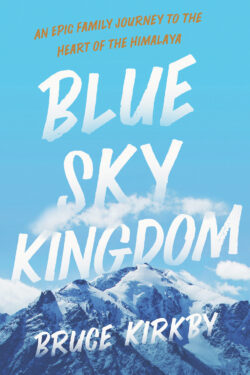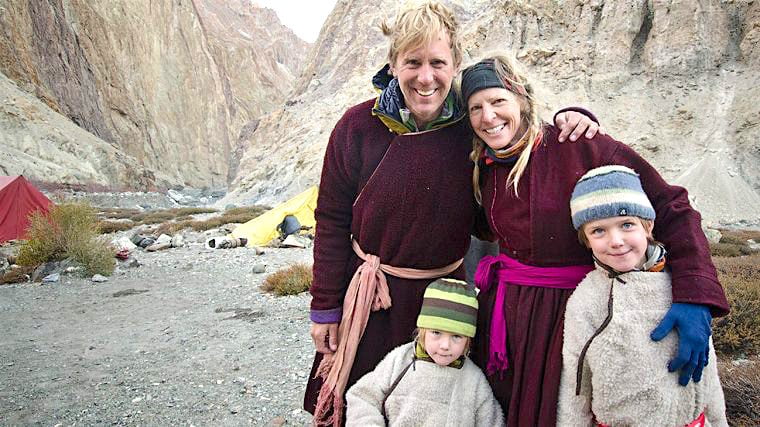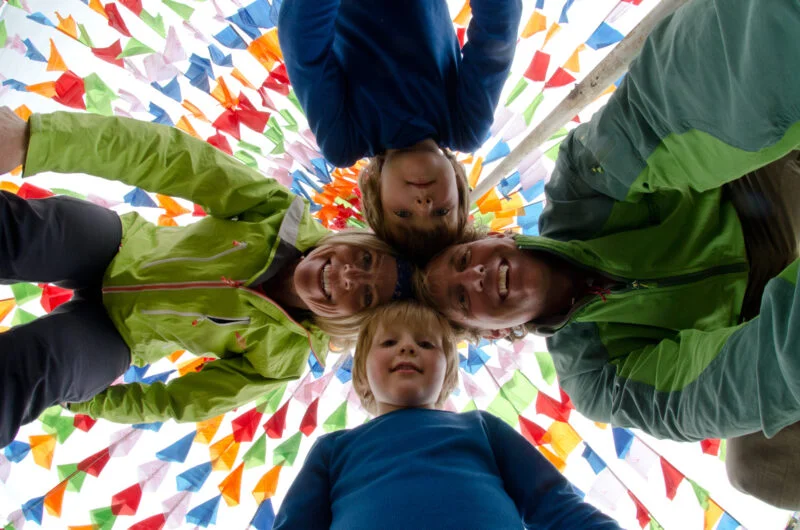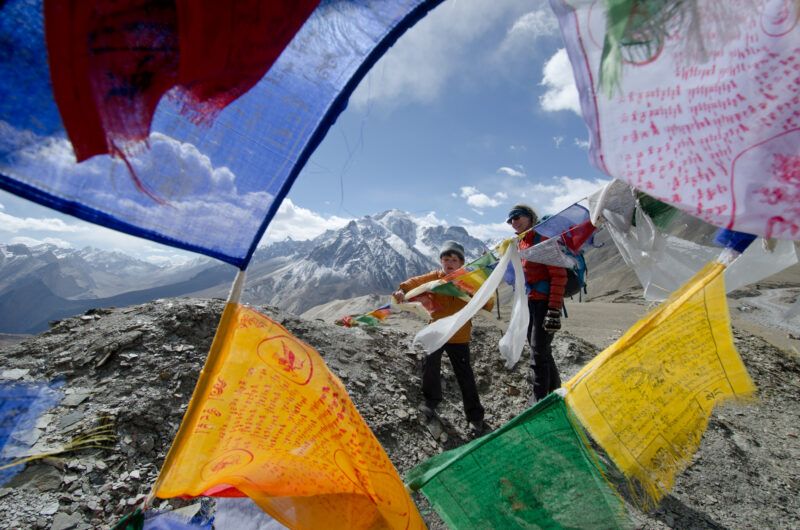#906 East Kootenay to Himalaya
Blue Sky Kingdom: An Epic Family Journey to the Heart of the Himalaya
by Bruce Kirkby
Madeira Park: Douglas & McIntyre, 2020
$34.95 / 9781771622691
Reviewed by Éric Spalding
*
 In Blue Sky Kingdom, Bruce Kirkby goes to a Buddhist monastery high up in the Himalayas. Accompanying the author on the trip are his wife Christine and their two sons, Bodi (7) and Taj (3). A film crew is also on hand for the first part of the journey from British Columbia to India. The outcome of the filmmakers’ efforts is a television series entitled Big Crazy Family Adventure that appeared on the Travel Channel in 2015.
In Blue Sky Kingdom, Bruce Kirkby goes to a Buddhist monastery high up in the Himalayas. Accompanying the author on the trip are his wife Christine and their two sons, Bodi (7) and Taj (3). A film crew is also on hand for the first part of the journey from British Columbia to India. The outcome of the filmmakers’ efforts is a television series entitled Big Crazy Family Adventure that appeared on the Travel Channel in 2015.
I appreciated how open Kirkby is about himself. For instance, he discusses his dissatisfaction with his life at home: he spends too much time on social media; he finds life too hectic; he feels isolated. He is also open about his wife and children, particularly Bodi, who has autism spectrum disorder. In the past, his diagnosis would have been “Asperger syndrome.” Indeed, at one point, the boy refers to himself as an “Ass Burger” (p. 256). Bodi misses social cues and becomes upset when his routines are disrupted. Happily, as the family’s journey progresses, his condition improves. Is he maturing? Does monastery life have a calming effect? The answer is probably “both.” In any case, the book should be rewarding for any reader who is preoccupied about autism. Indeed, the people who still mention Big Crazy Family Adventure to Kirkby are often parents of autistic children who find comfort in seeing how the author and his wife handle their son’s mood swings.


Kirkby’s story can be divided into three parts: the trip out (pp. 1-74), the stay at the monastery (pp. 75-250), and the trip back (pp. 251-284). From beginning to end, the author takes pains to provide detailed descriptions of his surroundings. In addition, many of Bodi’s drawings appear throughout. The boy illustrates objects that may be unfamiliar to the average Western reader. Enterprising readers can also go to travelchannel.com for photographs of the trip (there are none in the book itself), an interview with Kirkby and his wife, excerpts from the TV series, and more.
In the first part, Kirkby narrates the 52-day journey out to the monastery. No planes are boarded for this section of the voyage. The family, followed by the film crew, gets from home in Kimberley in the East Kootenay to Vancouver by truck, canoe, train and taxi. Kirkby and company then board a cargo ship, arriving in Busan, South Korea after over two weeks at sea. There ensues a journey by ferry, taxi, train, car and riverboat all the way to Manali, India, at which point the family hikes the remaining 150 kilometres to its destination, the remote Zanskar region. The entire trip up to the arrival at the monastery is the subject of Big Crazy Family Adventure. Kirkby notes that the show was a commercial failure, “bumped from prime time after just three weeks, and replaced by a far safer ratings bet, Bikinis and Boardwalks” (p. 271).
There is no film crew for the second part of the book, which focuses on the three months that Kirby and his family spend at the monastery. While the first part was hectic and ever-changing, this part is calm and still. In the monastery, conditions are rudimentary, but the monks who live there appear happy to Kirkby. The author does, however, remark that a highway connecting this remote land to the rest of India is under construction. In joining the rest of the world, the inhabitants will acquire some of the amenities of modern life. At the same time, Kirkby anticipates that they will have to cope with social acceleration, increasing inequalities, and a lack of time to meditate and socialize.
While at the monastery, the author himself tries to meditate. He writes:
My thoughts settled on my breathing, and as I gazed across the barren valley — a landscape devoid of physical distraction, resting under a dome of depthless blue sky — I understood Zanskar as the physical manifestation of a meditator’s mind. One breath in. Another out. A blue-sky metaphor is often employed in meditative teachings. When storms descend upon our lives, as they inevitably do, we tend to focus on the clouds — problems, conflict, anxiety, distress, depression — forgetting that the blue sky is always there, but hidden from view, somewhere above (p. 207).

There are many such reflections throughout the book, although I thought that there would be more about Buddhism per se. In this regard, Kirkby writes:
I hadn’t found a guru during our months there. Nor had I learned any Buddhist theory. And my meditative efforts remained inconsistent at best. Nonetheless, the ancient way of life we’d glimpsed felt vitally important (p. 262).
The monks are inspiring not so much for what they teach as for what they do. They pray, meditate, and chant together, they support and help each other out, they are sensitive to the changes of season, they waste nothing, and they are creative and artistic.
Even so, Kirkby is careful to not idealize the time his family spends in Zanskar. Nothing grievous befalls the four visitors, but they do face communication problems, boredom, unappetizing food, ill health, and exhaustion from long hikes and farm labour. Moreover, Kirkby and his wife try to teach English and mathematics to young novice monks. Unfortunately, like schoolboys around the world, the latter are often hard to manage.
The return trip, which accounts for the third part of the book, includes its share of challenges, as the family members cross a mountain pass on horse and on foot. It is their final adventure before a return to the comforts of hotels in Rajasthan and Delhi and a long flight back to BC. The book closes on a touching image that left me smiling. In the end, I was happy to spend the time I did with Bruce, Christine, Bodi and Taj.

*

Éric Spalding lives in Surrey. He has contributed book reviews to The Canadian Journal of Communication, The Pacific Rim Review of Books, Scholarly and Research Communication, and the Vancouver Sun. Originally from Montreal, Éric teaches in the Department of Social, Cultural, & Media Studies at University of the Fraser Valley.
*
The Ormsby Review. More Books. More Reviews. More Often.
Publisher and Editor: Richard Mackie
The Ormsby Review is a journal service for in-depth coverage of B.C. books and authors. The Advisory Board consists of Jean Barman, Robin Fisher, Cole Harris, Wade Davis, Hugh Johnston, Patricia Roy, David Stouck, and Graeme Wynn. Scholarly Patron: SFU Graduate Liberal Studies. Honorary Patron: Yosef Wosk. Provincial Government Patron since September 2018: Creative BC
“Only connect.” – E.M. Forster